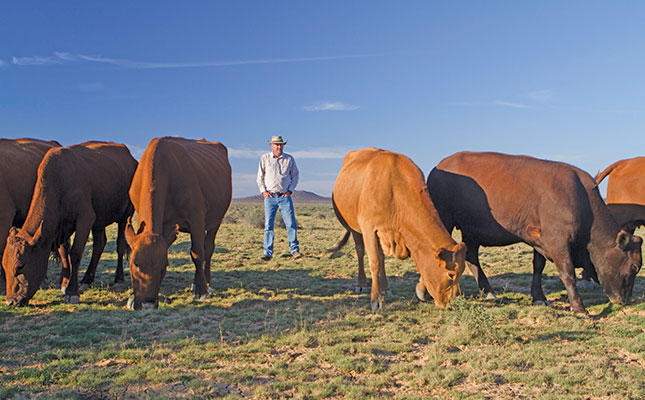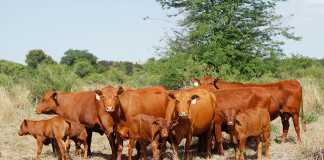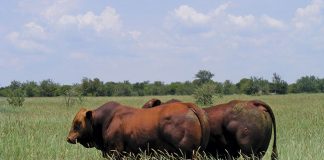
Photo: Sabrina Dean
Like many farmers in parts of the Northern Cape, Ben Raath has experienced several consecutive years of below-average rainfall.
Unlike most others in his region, however, he runs cattle. Raath’s father, Theo, started farming Dorper sheep, animals more typical in this area, on the farm Donkerhoek just outside Britstown in the Pixley ka Seme district in 1961. At a stocking rate of about 1 LSU/22ha, cattle had never seemed viable.
“I’m often asked how I manage to farm cattle here,” says Raath.
Diversified interests
Raath farmed with his father from 1992 until Theo’s death in 2007. In 2014, Raath made the switch to Merino.
The risk with Dorpers, he says, is that if a lamb is lost, there is nothing to sell, whereas with Merino, one is at least left with the wool produced by the ewe. “Also, if you want to farm sustainably in future, I believe you must have an export product, such as wool, to market.”
Although sheep are better suited to this terrain, risks such as stock theft and predation made Raath further diversify his business. One concern he began years ago is an exotic parrot-breeding operation specialising in Convention on International Trade in Endangered Species-approved macaws, African greys and other parrot-type species for export.
He also has a game component and has invested in good-quality genetic stock of several species, such as gemsbok and springbok.
The other operation is his Tuli stud component, comprising roughly 100 breeding cows.
“My breeding philosophy is about producing functional, effective animals that are fertile, hardy and adapted to extreme conditions,” he says.
“If an animal can survive here where we farm, it can survive anywhere in South Africa.”
Inherent hardiness
When searching for appropriate cattle breeds to run in 2008, Raath investigated indigenous breeds.
While buying Dorpers from his friend Rickus van der Merwe, he had a closer look at his Tuli cattle.
“On that day, I fell in love with the breed. My only decision was whether I was going to run a stud or commercial operation.”
Despite the high cost associated with starting up a stud breeding operation, Raath decided that the investment would be worthwhile in the long run.
He explains that the Tuli is a medium-frame animal, with close to 90% of the breed polled.His cows have an average weight of 430kg to 450kg, are hardy and adaptable, and can survive on the tough veld with only limited home-mixed lick.
“They are very fertile and calve easily,” he says.
Another key selling point is that they produce good weaner calves that do not get penalised in the feedlot. In fact, says Raath, some feedlots pay a premium for Tuli calves.
The breed is also popular among commercial farmers for use in terminal crossbreeding programmes with cattle such as Charolais or Bonsmara.
“If you take your input cost and compare it with the amount of meat you produce per hectare, there are few breeds that can beat the Tuli,” he says.
The average weaning weight for his bull calves is around 230kg, and for his heifers 210kg.
Built for extremes
According to Raath, the Tuli also has inherent characteristics to help it cope better in drought conditions or extreme heat.
Research has shown the correlation between a decline in fertility when a cow’s body temperature goes too high. He says it has also been proven that indigenous breeds such as the Tuli are better able to maintain a comfortable body temperature.
“Many commercial farmers also tell us that in extremely hot conditions, cows from other breeds stand under the trees while the Tulis continue grazing on the veld,” he says.
The Tuli is also a smooth-coated breed, which Raath says results in fewer ticks. Added to this is its inbred resistance to endemic diseases.
Raath also highlights its fertility and longevity. “I had a cow that was still calving at 19 years and have heard of some farmers with cows calving at 22 years,” he says.
Breeding season
Raath aims for at least 90% conception, with a 98% calving percentage and a weaning average of at least 95%.
“I want minimum calving problems,” he says simply.
At the end of the day, though, he selects to achieve one goal: a cow must wean at least 50% of her body weight every year.
He achieves an inter-calving period of around 384 days. At breeding time, he gives the cows three months to conceive due to the harsh terrain. He runs one bull to approximately 30 cows, but adjusts this according to his computerised planning system.
In the past, Raath always bred his cows from mid-January to mid-April. However, he believes seasons are shifting due to climate change and may therefore move his breeding season a month later, from mid-February to mid-May.
First-calf heifers are put to the bull six weeks prior to the cows’ breeding season, but only when they are about two years old. Raath then also weans the first calf earlier to allow the heifer a longer recovery before he places her with the cow herd in the next breeding season.
Technical selection
Raath does all the relevant recording necessary to comply with SA Stud Book and the Tuli Breeders’ Society of South Africa’s requirements. This enables him to provide prospective buyers with fact-based information needed to make a purchasing decision.
When it comes to prospective stud animals, he utilises computer-based software, analysing traits and inbreeding coefficients provided by tools such as the Logix system.
He records the birthweights of all animals, as well as weaning weights and weights at 12 and 18 months, in addition to weighing cows to provide figures for the cow-to-calf ratio.
Bulls are placed in an on-farm bull growth test from 12 months of age. An SA Stud Book adviser is present at completion of the test for the weighing of the bulls and recording body measurements such as scrotum circumference, height, length and skin thickness.
“We also do a real-time ultrasound scan to determine red meat yield, marbling, muscle area, fat distribution, and ratio of muscle, bone and fat to each other. This gives us an index and breeding value. This information, together with visual selection, is very helpful for the buyer in selecting the right bull.”
Raath stresses that measuring and recording are crucial to making informed decisions. While he uses technology and statistics for initial decision-making for his own breeding goals, he also relies on visual selection.
“The computer selects for me, then I go to the kraal, evaluate visually, and do corrective mating where necessary to get the best genetic progress.”
There is no such thing as a perfect animal, he explains, but the focus should always be on breeding for improvement.
About 10% of his male animals are sold as stud bulls. The remaining 60% are sold commercially and 30% are slaughtered. He keeps back sufficient replacement heifers and markets some stud cows and heifers, with the balance sold as commercial stock.
Terrain
Although the Britstown region is rated at a grazing capacity of about 1 LSU/22ha, Raath’s extensive operation is spread across several thousand hectares of Karoo-type veld.
“There isn’t much grazing, but very good plant diversity,” he says.
The grazing mix includes typical Karoo shrubs such as grey Karoo (Pentzia globosa, vaalkaroo in Afrikaans), wild aster (Felicia muricata, bloublommetjie), good Karoo (Phymaspermum parvifolium, witblommetjie), Salsola calluna (rooilootganna), silver Karoo (Plinthus karooicus), kapok bush (Eriocephalus ericoides) and anchor Karoo (Pentzia incana, alsbossie).
sweetgrass mix includes fingergrass species such as Digitaria eriantha (vingergras), Bushman grass species Stipagrostis ciliata (langbeenboesman) and Stipagrostis obtusa (kortbeenboesman), Eragrostis species (Eragrostis bicolor, fynvleigras) and Eragrostis curvula (oulandsgras), stick grass (Aristida congesta, witsteekgras), feather fingergrass (Chloris virgata, klossiegras), common dropseed (Sporobolus fimbriatus, fynsaad), and red grass (Themeda triandra).
Rainfall averages 225mm per annum, with most of it occurring in summer, but the last few years have not delivered much more than 100mm. In addition to less rainfall, the frequency and intensity of weather events are erratic.
Rain now occurs in sudden heavy downpours that cause erosion, compared with the extended, soft rain of years ago that seeped into the ground.
The number of hot days has also increased and the duration of hot stretches is greater. The last few years have placed tremendous pressure on his operation, Raath admits, with a feed bank near the homestead testifying to the money he has had to spend to keep his stud herd going.
Phone Ben Raath on 083 468 6176, or email him at [email protected]. Visit donkerhoektulis.co.za.











